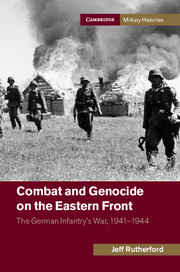Book contents
- Frontmatter
- Table of contents
- List of illustrations
- List of figures
- List of maps
- List of tables
- Acknowledgments
- Introduction
- 1 The Wehrmacht and German society
- 2 Preparations for war
- 3 “Attack with a ruthless offensive spirit and … a firestorm of destruction”
- 4 “Will the continuation of this attackbe worth it?”
- 5 “It is only a question of where, not if, civilians will starve”
- 6 The failure of Operation Barbarossa
- 7 The Soviet winter offensive, 1942
- 8 “The population … shouted out to the interpreter that one would rather be shot instead of being left to starve”
- 9 “From one mess to another”
- 10 “We need to fight to the end, so oder so”
- 11 A more rational occupation?
- 12 “As miserable representatives of themiserable twentieth century, we burnedall of the villages”
- Conclusion
- Bibliography
- Index
- References
5 - “It is only a question of where, not if, civilians will starve”
The 121st Infantry Division and the occupation of Pavlovsk
Published online by Cambridge University Press: 05 July 2014
- Frontmatter
- Table of contents
- List of illustrations
- List of figures
- List of maps
- List of tables
- Acknowledgments
- Introduction
- 1 The Wehrmacht and German society
- 2 Preparations for war
- 3 “Attack with a ruthless offensive spirit and … a firestorm of destruction”
- 4 “Will the continuation of this attackbe worth it?”
- 5 “It is only a question of where, not if, civilians will starve”
- 6 The failure of Operation Barbarossa
- 7 The Soviet winter offensive, 1942
- 8 “The population … shouted out to the interpreter that one would rather be shot instead of being left to starve”
- 9 “From one mess to another”
- 10 “We need to fight to the end, so oder so”
- 11 A more rational occupation?
- 12 “As miserable representatives of themiserable twentieth century, we burnedall of the villages”
- Conclusion
- Bibliography
- Index
- References
Summary
Following its arrival in Pavlovsk on 19 September 1941, the 121st ID settled into its position in the Leningrad siege line, a spot occupied by the East Prussians until 30 April 1942, when they deployed to the Volkhov region. The division’s occupation of Pavlovsk is instructive for several reasons. First, its experiences during this time period significantly differ from those of the 123rd and 126th IDs, highlighting the difficulty in ascribing one master narrative for all German units during Operation Barbarossa. Second, the fate of Pavlovsk fits into two larger and interconnected themes: general German policy towards Soviet urban centers and, more specifically, German objectives towards Leningrad as well as the Wehrmacht’s complicity with the regime’s planned war of annihilation. Up until this point in the war, the men of the 121st, 123rd, and 126th IDs generally fought their war only alongside other Wehrmacht units. With the ending of the advance, however, the nature of the war transformed and various German organizations, such as the Economic Staff East and the SS-Police, now began to work much more closely with Army Group North’s combat infantry in occupying and securing Hitler’s newly conquered eastern empire. The primary mission of frontline combat divisions certainly remained that of defeating the Red Army in battle. The end of the blitzkrieg, however, also meant that the German infantry now had to assume tasks that it was simply unprepared for, and this led it into the larger exploitative web spun by other Nazi institutions in the East.
- Type
- Chapter
- Information
- Combat and Genocide on the Eastern FrontThe German Infantry's War, 1941–1944, pp. 151 - 196Publisher: Cambridge University PressPrint publication year: 2014



